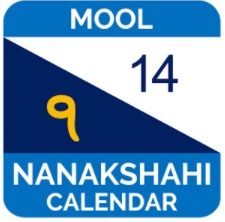The Difference Between The Two. Click on respective links for details under each calendar.
Nanakshahi
- Based on length of Tropical year 365d 5h 48m 45s
- Days in months 31 or 30; first five months contain31 days each and last seven 30 days each -a verysimple rule to remember.
- Fixed leap year rule -last month to have 1 extra dayevery four years
- Fixed dates of Sangrands in Common Era
- Permanent relation between seasons and months; will stay according to Gurbani
- Gurpurbs on fixed dates according to both Nanakshahi and Common Era calendars
- All Gurpurbs occur once every year, according to both NS and CE calendars.
- No ‘unclean’ month (malmaas) in the year. No month or day is ‘clean’ or ‘unclean’ according to Gurbani
- Gurpurbs fixed according to solar dates e.g. 23 Pohfor Parkash of Guru Gobind Singh Sahib, and 23th
Poh will always occur on 5 January. (We gaveprecedence to the original solar dates over the lunar dates and English dates.)
Bikrami
- Based on Sidereal year 365d 6h 9m 10s
- Months may contain 29,30,31 or 32 days; no simple rule for determination of the number of days in a given month.
- No fixed rule
- Sangrand depends on entrance of sun into ‘rasis’, dates of Sangrands not fixed in Common Era.
- Months will shift in seasons – on the average by 1 dayper70/71years-alreadyshiftof7/8days since Guru Nanak Sahib’s time
6. Gurpurb dates change from year to year in CE calendar
7. In some years no Parkash Gurpurb of Guru Gobind Singh Sahib, while in others it occurs twice in one year of the CE calendar. In 1999 CE there was no Parkash Gurpurb of Guru Gobind Singh Sahib.
8. A ‘mal mas’ or ‘unclean month’ is added every two or three years in the lunar year to keep it in step with the solar year. In this month Gurpurbs cannot becelebrated. This whole thing is contrary to Gurbani.
9. Gurpurbs fixed according to lunar dates e.g Poh Sudi 7, therefore, changing from year to year in CE calendar. The lunar year contains 354 / 355 days while solar year 365 / 366 days. When ‘mal mas’ is added the lunar year becomes 383 / 384 days long. In 2000 CE Poh Sudi 7 was on 13th January according to Surya Siddhanta Panchangas (UP), while on 14th January according to Punjab Panchangs. So the same Gurpurb was celebrated on th two different dates – on 13th January in Patna Sahib, and by some in Punjab on 14th January. Another problem of the lunar calendar is that the same ‘tithi’ can happen on two days or two ‘tithis’ can happen on one day.
